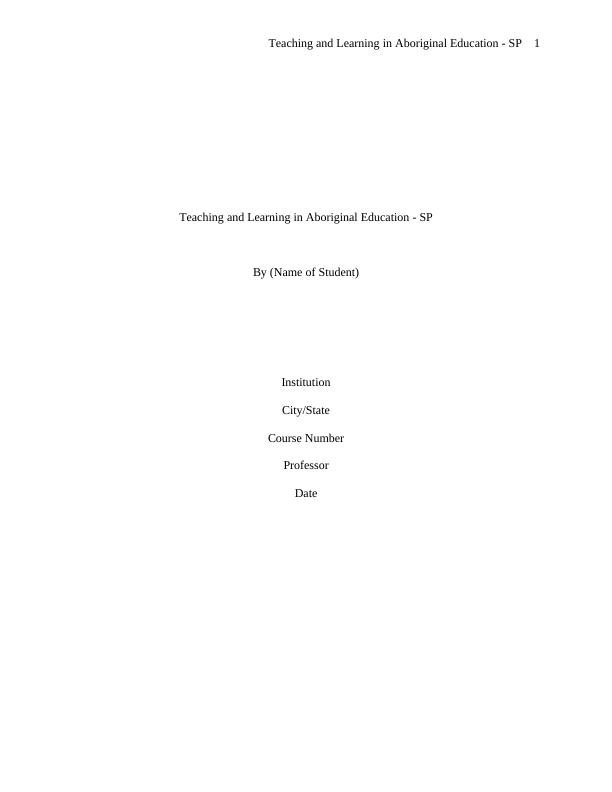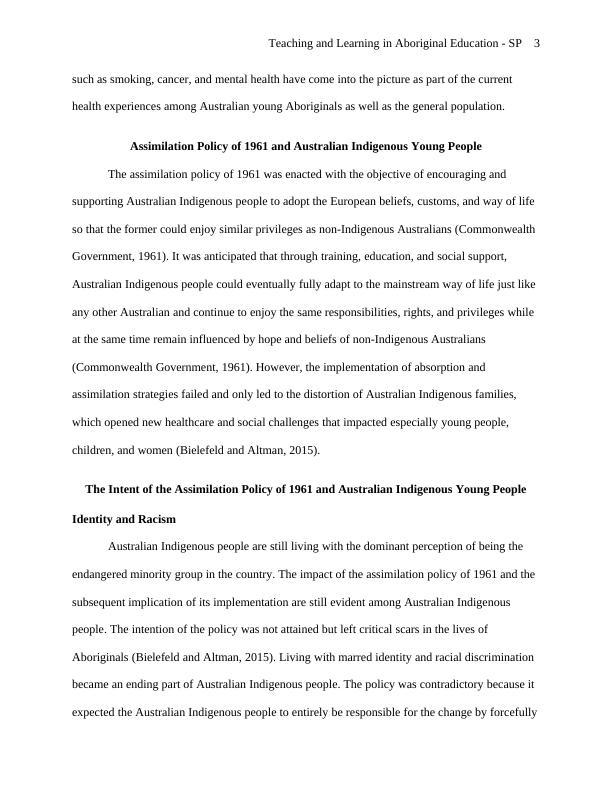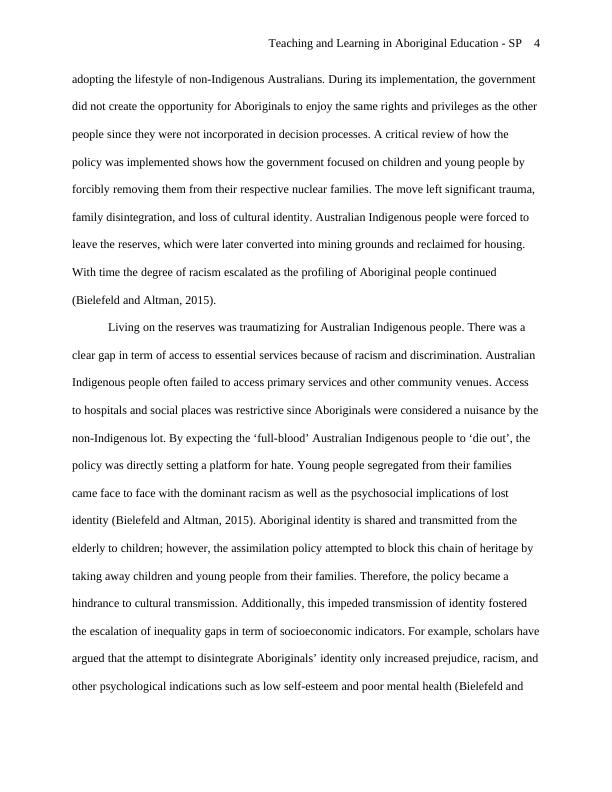Teaching and Learning in Aboriginal Education - SP
Added on 2022-11-02
13 Pages3617 Words445 Views
Teaching and Learning in Aboriginal Education - SP 1
Teaching and Learning in Aboriginal Education - SP
By (Name of Student)
Institution
City/State
Course Number
Professor
Date
Teaching and Learning in Aboriginal Education - SP
By (Name of Student)
Institution
City/State
Course Number
Professor
Date

Teaching and Learning in Aboriginal Education - SP 2
Teaching and Learning in Aboriginal Education - SP
Pre-Invasion Health Status of Australian Indigenous Young People
Consistent and comprehensive data about the previous health indicators of Australian
Indigenous people is an impeding factor to successful evaluation of the pre-invasion health status
just like it is equally evident when evaluating socioeconomic factors (Kickett and Shahid, 2019).
However, the existing evidence points out that Australian Indigenous people were associated
with a high rate of mortality that affected children, young people, and older adults. The high
mortality rate emanated from the prevalence of respiratory infection and other infectious diseases
among Australian Indigenous people. Young people equally suffered from communicable
diseases as well as nutritional conditions (Shepherd, Li, and Zubrick, 2012). Communicable
diseases were responsible for about 60% of the gap in life expectancy between Australian
Indigenous people and non-Aboriginals (MacRae, Thomson, Anomie, Catto, Gray, Levitan,
McLoughlin, Potter, Ride, Stumpers, Trzesinski, and Urquhart, 2013.).
Present Health Status of Australian Indigenous Young People
The onset of improved health awareness through sensitization, training of nurses,
improved housing, and enactment of inclusion policies transformed the pre-invasion health status
of Australian Indigenous people. Currently, there is a decrease in mortality rate, respiratory
infection, and reported communicable diseases among young people (MacRae et al., 2013.). The
same trend is also evident in other age brackets. Although the current statistics indicate a positive
change when compared to the pre-invasion period, the statistics still show the existence of
disparity in healthcare between Indigenous and non-Aboriginal people (Kickett and Shahid,
2019; Shepherd, Li, and Zubrick, 2012). It is necessary to note that other health-related issues
Teaching and Learning in Aboriginal Education - SP
Pre-Invasion Health Status of Australian Indigenous Young People
Consistent and comprehensive data about the previous health indicators of Australian
Indigenous people is an impeding factor to successful evaluation of the pre-invasion health status
just like it is equally evident when evaluating socioeconomic factors (Kickett and Shahid, 2019).
However, the existing evidence points out that Australian Indigenous people were associated
with a high rate of mortality that affected children, young people, and older adults. The high
mortality rate emanated from the prevalence of respiratory infection and other infectious diseases
among Australian Indigenous people. Young people equally suffered from communicable
diseases as well as nutritional conditions (Shepherd, Li, and Zubrick, 2012). Communicable
diseases were responsible for about 60% of the gap in life expectancy between Australian
Indigenous people and non-Aboriginals (MacRae, Thomson, Anomie, Catto, Gray, Levitan,
McLoughlin, Potter, Ride, Stumpers, Trzesinski, and Urquhart, 2013.).
Present Health Status of Australian Indigenous Young People
The onset of improved health awareness through sensitization, training of nurses,
improved housing, and enactment of inclusion policies transformed the pre-invasion health status
of Australian Indigenous people. Currently, there is a decrease in mortality rate, respiratory
infection, and reported communicable diseases among young people (MacRae et al., 2013.). The
same trend is also evident in other age brackets. Although the current statistics indicate a positive
change when compared to the pre-invasion period, the statistics still show the existence of
disparity in healthcare between Indigenous and non-Aboriginal people (Kickett and Shahid,
2019; Shepherd, Li, and Zubrick, 2012). It is necessary to note that other health-related issues

Teaching and Learning in Aboriginal Education - SP 3
such as smoking, cancer, and mental health have come into the picture as part of the current
health experiences among Australian young Aboriginals as well as the general population.
Assimilation Policy of 1961 and Australian Indigenous Young People
The assimilation policy of 1961 was enacted with the objective of encouraging and
supporting Australian Indigenous people to adopt the European beliefs, customs, and way of life
so that the former could enjoy similar privileges as non-Indigenous Australians (Commonwealth
Government, 1961). It was anticipated that through training, education, and social support,
Australian Indigenous people could eventually fully adapt to the mainstream way of life just like
any other Australian and continue to enjoy the same responsibilities, rights, and privileges while
at the same time remain influenced by hope and beliefs of non-Indigenous Australians
(Commonwealth Government, 1961). However, the implementation of absorption and
assimilation strategies failed and only led to the distortion of Australian Indigenous families,
which opened new healthcare and social challenges that impacted especially young people,
children, and women (Bielefeld and Altman, 2015).
The Intent of the Assimilation Policy of 1961 and Australian Indigenous Young People
Identity and Racism
Australian Indigenous people are still living with the dominant perception of being the
endangered minority group in the country. The impact of the assimilation policy of 1961 and the
subsequent implication of its implementation are still evident among Australian Indigenous
people. The intention of the policy was not attained but left critical scars in the lives of
Aboriginals (Bielefeld and Altman, 2015). Living with marred identity and racial discrimination
became an ending part of Australian Indigenous people. The policy was contradictory because it
expected the Australian Indigenous people to entirely be responsible for the change by forcefully
such as smoking, cancer, and mental health have come into the picture as part of the current
health experiences among Australian young Aboriginals as well as the general population.
Assimilation Policy of 1961 and Australian Indigenous Young People
The assimilation policy of 1961 was enacted with the objective of encouraging and
supporting Australian Indigenous people to adopt the European beliefs, customs, and way of life
so that the former could enjoy similar privileges as non-Indigenous Australians (Commonwealth
Government, 1961). It was anticipated that through training, education, and social support,
Australian Indigenous people could eventually fully adapt to the mainstream way of life just like
any other Australian and continue to enjoy the same responsibilities, rights, and privileges while
at the same time remain influenced by hope and beliefs of non-Indigenous Australians
(Commonwealth Government, 1961). However, the implementation of absorption and
assimilation strategies failed and only led to the distortion of Australian Indigenous families,
which opened new healthcare and social challenges that impacted especially young people,
children, and women (Bielefeld and Altman, 2015).
The Intent of the Assimilation Policy of 1961 and Australian Indigenous Young People
Identity and Racism
Australian Indigenous people are still living with the dominant perception of being the
endangered minority group in the country. The impact of the assimilation policy of 1961 and the
subsequent implication of its implementation are still evident among Australian Indigenous
people. The intention of the policy was not attained but left critical scars in the lives of
Aboriginals (Bielefeld and Altman, 2015). Living with marred identity and racial discrimination
became an ending part of Australian Indigenous people. The policy was contradictory because it
expected the Australian Indigenous people to entirely be responsible for the change by forcefully

Teaching and Learning in Aboriginal Education - SP 4
adopting the lifestyle of non-Indigenous Australians. During its implementation, the government
did not create the opportunity for Aboriginals to enjoy the same rights and privileges as the other
people since they were not incorporated in decision processes. A critical review of how the
policy was implemented shows how the government focused on children and young people by
forcibly removing them from their respective nuclear families. The move left significant trauma,
family disintegration, and loss of cultural identity. Australian Indigenous people were forced to
leave the reserves, which were later converted into mining grounds and reclaimed for housing.
With time the degree of racism escalated as the profiling of Aboriginal people continued
(Bielefeld and Altman, 2015).
Living on the reserves was traumatizing for Australian Indigenous people. There was a
clear gap in term of access to essential services because of racism and discrimination. Australian
Indigenous people often failed to access primary services and other community venues. Access
to hospitals and social places was restrictive since Aboriginals were considered a nuisance by the
non-Indigenous lot. By expecting the ‘full-blood’ Australian Indigenous people to ‘die out’, the
policy was directly setting a platform for hate. Young people segregated from their families
came face to face with the dominant racism as well as the psychosocial implications of lost
identity (Bielefeld and Altman, 2015). Aboriginal identity is shared and transmitted from the
elderly to children; however, the assimilation policy attempted to block this chain of heritage by
taking away children and young people from their families. Therefore, the policy became a
hindrance to cultural transmission. Additionally, this impeded transmission of identity fostered
the escalation of inequality gaps in term of socioeconomic indicators. For example, scholars have
argued that the attempt to disintegrate Aboriginals’ identity only increased prejudice, racism, and
other psychological indications such as low self-esteem and poor mental health (Bielefeld and
adopting the lifestyle of non-Indigenous Australians. During its implementation, the government
did not create the opportunity for Aboriginals to enjoy the same rights and privileges as the other
people since they were not incorporated in decision processes. A critical review of how the
policy was implemented shows how the government focused on children and young people by
forcibly removing them from their respective nuclear families. The move left significant trauma,
family disintegration, and loss of cultural identity. Australian Indigenous people were forced to
leave the reserves, which were later converted into mining grounds and reclaimed for housing.
With time the degree of racism escalated as the profiling of Aboriginal people continued
(Bielefeld and Altman, 2015).
Living on the reserves was traumatizing for Australian Indigenous people. There was a
clear gap in term of access to essential services because of racism and discrimination. Australian
Indigenous people often failed to access primary services and other community venues. Access
to hospitals and social places was restrictive since Aboriginals were considered a nuisance by the
non-Indigenous lot. By expecting the ‘full-blood’ Australian Indigenous people to ‘die out’, the
policy was directly setting a platform for hate. Young people segregated from their families
came face to face with the dominant racism as well as the psychosocial implications of lost
identity (Bielefeld and Altman, 2015). Aboriginal identity is shared and transmitted from the
elderly to children; however, the assimilation policy attempted to block this chain of heritage by
taking away children and young people from their families. Therefore, the policy became a
hindrance to cultural transmission. Additionally, this impeded transmission of identity fostered
the escalation of inequality gaps in term of socioeconomic indicators. For example, scholars have
argued that the attempt to disintegrate Aboriginals’ identity only increased prejudice, racism, and
other psychological indications such as low self-esteem and poor mental health (Bielefeld and

End of preview
Want to access all the pages? Upload your documents or become a member.
Related Documents
Aboriginal Healthlg...
|11
|2994
|260
Policy of Assimilation 1961: Impact on Health Outcomes of Australian Indigenous Young Peopleslg...
|13
|3460
|255
Health Care of Aboriginals and Torres Strait Islanderslg...
|12
|3195
|7
Healthcare for Australian Indigenous Elderslg...
|12
|3044
|359
Indigenous Young People Case Study 2022lg...
|10
|2863
|7
Australian Indigenous Young Peopleslg...
|12
|3039
|262
